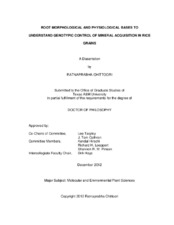| dc.description.abstract | Rice (Oryza sativa L.) supports half of the human population. However, predominant rice consumption leads to malnutrition due to mineral deficiencies. The research goal was to support identification of genes responsible for the uptake/accumulation of potassium (K), iron (Fe), zinc (Zn) and molybdenum (Mo), thus promoting the breeding for rice with high grain concentrations of these elements. Prior studies identified rice genotypes with high grain-K, -Fe, -Zn or -Mo concentrations that were hypothesized to be due to differences in root traits. The research objective was to identify root traits associated with these elements. These traits could be bases for identifying genes. The first study determined if these genotypes showed similar accumulation patterns in leaves as in grains, which would hint at influences of the roots and enable identifying distinct root traits and possible genes in vegetative growth stages. The second study determined if root traits of high grain-Mo genotypes displayed an acid-tolerance mechanism as these genotypes originated from Malaysia where acidic soils strongly adsorb Mo making it unavailable for plants. The third study identified root trait differences of high grain-K, -Fe, -Zn and -Mo genotypes in hydroponics media, while the fourth determined root trait differences in these genotypes in sand-culture media including a 1-Naphthalene Acetic Acid (NAA) seed treatment for perturbation.
The first study identified several high grain-Mo genotypes with similar Mo accumulation patterns in V4 to V6 stage-leaves as in grains, suggestive of a root influence. The second study established that gross morphological and physiological root traits of a high grain-Mo genotype were not part of an acid-tolerance mechanism. Neither the third nor fourth study identified root traits related to shoot K, Fe, Zn or Mo concentration, however positive associations of seedling vigor traits with several beneficial elements, including K, and negative associations with numerous toxic elements were established. Lack of correlation with root traits suggests other mechanisms (e.g. active uptake transporters) instead control the observed grain accumulation differences. Based on the fourth study, either direct effects of NAA on element uptake/transfer or indirect effects on soil pH and redox potential altered tissue Fe and Zn levels. | en |


